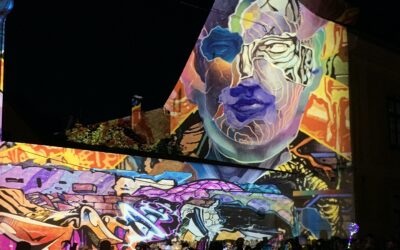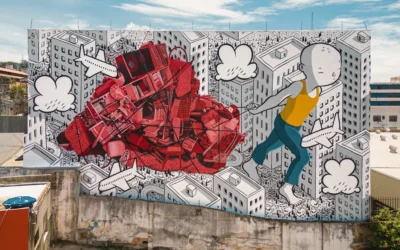Miss KK reworked her favourite Renaissance paintings and paired them with characters from her childhood. The theme of the exhibition was based around her painting "Boticelli - Birth of Venus". It was the first painting in which nudity was not portrayed as a sin.
Miss KK introduces you to her exhibition
The birth of Venus
The exhibition is called MODERN RENAISSANCE, because I've reworked my favourite Renaissance paintings and paired them with characters from my childhood. If you ask someone what their favourite painting of all the paintings in the world is, they usually can't pick one. I know what one is for me straight away. The Birth of Venus by Boticelli. Simply perfect, beautiful, complex and yet clear. It was extremely innovative when it was done, before that it was always painted on wood, but Boticelli created it on canvas.

📸 Photo by Daniel Gaál
Apart from the colours, I also like the fact that this was the first painting in which nudity was not portrayed as a sin, as it always was before, and always associated with Eve. And that one is born in a state of nakedness, or 'nothing / boundless', but as Venus comes ashore - she is clothed... She is made something, she is delimited, she is defined. One can think of her as a flowery dresser, or even 'romantic' if you look at her today, if you break it down into styles of dress (rocker, rapper, punk, alter, bohemian romantic, etc.) I was really struck by this idea of how Venus' nakedness has so much mystery, yet she shows everything. But it's really her dressing that gives her a sense of style and a sense of style that can even reflect a character trait.
Realisation
This was the starting point, and I built the other dolls around it. I started working on the Venus picture about 7 years ago, but somehow there was no occasion to show it, no space. Then when I was asked to exhibit at the Telepen, I knew immediately that this would be a good topic.

📸 Photo by Daniel Gaál

Belts of the city.
Their outlet is the concrete jungle.
They are there in abandoned doorways, dusty shop windows, on iron doors that once saw better days, in scrawled telephone boxes.
Now they have moved to the Telep.
Then came the Mona Lisa adaptation, which is another classic favourite of mine. Or rather, I wanted to show it on a new surface. The goal was a monumental doll that exists in space, not on the wall. So the sponge doll was born.

📸 Photo by Daniel Gaál

📸 Photo by Daniel Gaál


📸 Photo by Daniel Gaál
Venus was bound to be a mural, clearly giving itself to the surface between the two columns in the gallery.
And I wanted to hang the Mona Lisa, so that it could stand in space and be walked around. And because the base work is a very sombre colour, brown, burgundy, greyish green, I brightened up her dress and made her face a little more cheerful.
A closer look at the main character
I intended Venus to be a nude tone, as she is nude in the original. I didn't vary him too much, I let the other characters have a similar feel to the original, just with a bit more textiles/accessories. But the message written on the main character was important for him to come to the fore and be able to assert himself (YOU ARE SO USED TO YOUR FEATURES, YOU DON'T KNOW HOW BEAUTIFUL YOU LOOK TO A STRANGER). It's a great truth, we tend to even feel it as a flaw, to get used to our own features, even though it's what makes us charming and special.

📸 Photo by Daniel Gaál

Each doll has a message on it, which I write first and foremost to myself. But I'm also very happy to get more and more feedback from passers-by that they love them, listen to them, collect them because they identify with them, think about them or smile about them.

This is also my aim, to address the dolls on the street, to give the viewer a nice or funny thought.
Creation process
I work with photomontage techniques, digitally, in Photoshop.
I use about 50 photos for a doll, face, hair, headdress, arms, clothes, legs, shoes, etc... And lots of accessories and always with a caption.



📸 Photo by Daniel Gaál
I try to generalise the faces of the street dolls, don't notice them because of the person, because it's not important who the character is, but what they say. I mostly use a lesser known face so that you can approach it without expectation. But for the exhibition it was important to be familiar, to remember him, to remember him.
Feedback
I got good comments from everyone, I was a bit nervous that it wouldn't look small, but in the end I was satisfied because it was varied and the emphasis was on exciting surfaces and gigantic sizes. The Mona Lisa in the space was the favourite of most visitors.

📸 Photo by Daniel Gaál










